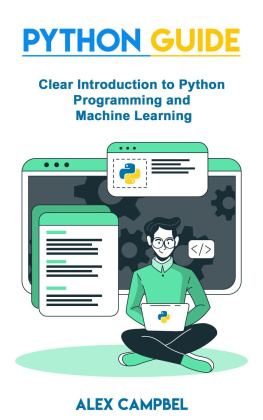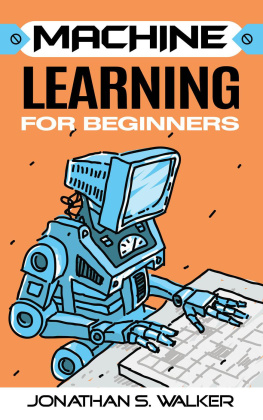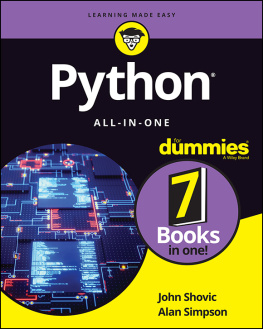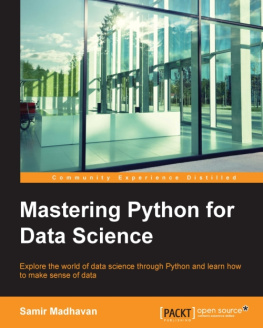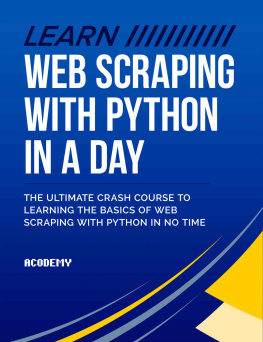Vickler - Python: 3 books in 1 : Python basics for Beginners + Python Automation Techniques And Web Scraping + Python For Data Science And Machine Learning
Here you can read online Vickler - Python: 3 books in 1 : Python basics for Beginners + Python Automation Techniques And Web Scraping + Python For Data Science And Machine Learning full text of the book (entire story) in english for free. Download pdf and epub, get meaning, cover and reviews about this ebook. year: 2021, genre: Computer. Description of the work, (preface) as well as reviews are available. Best literature library LitArk.com created for fans of good reading and offers a wide selection of genres:
Romance novel
Science fiction
Adventure
Detective
Science
History
Home and family
Prose
Art
Politics
Computer
Non-fiction
Religion
Business
Children
Humor
Choose a favorite category and find really read worthwhile books. Enjoy immersion in the world of imagination, feel the emotions of the characters or learn something new for yourself, make an fascinating discovery.

Python: 3 books in 1 : Python basics for Beginners + Python Automation Techniques And Web Scraping + Python For Data Science And Machine Learning: summary, description and annotation
We offer to read an annotation, description, summary or preface (depends on what the author of the book "Python: 3 books in 1 : Python basics for Beginners + Python Automation Techniques And Web Scraping + Python For Data Science And Machine Learning" wrote himself). If you haven't found the necessary information about the book — write in the comments, we will try to find it.
Python: 3 books in 1 : Python basics for Beginners + Python Automation Techniques And Web Scraping + Python For Data Science And Machine Learning — read online for free the complete book (whole text) full work
Below is the text of the book, divided by pages. System saving the place of the last page read, allows you to conveniently read the book "Python: 3 books in 1 : Python basics for Beginners + Python Automation Techniques And Web Scraping + Python For Data Science And Machine Learning" online for free, without having to search again every time where you left off. Put a bookmark, and you can go to the page where you finished reading at any time.
Font size:
Interval:
Bookmark:

Copyright 2021 - All rights reserved.
In no way is it legal to reproduce, duplicate, or transmit any part of this document in either electronic means or in printed format. Recording of this publication is strictly prohibited and any storage of this document is not allowed unless with written permission from the publisher. All rights reserved.
The information provided herein is stated to be truthful and consistent, in that any liability, in terms of inattention or otherwise, by any usage or abuse of any policies, processes, or directions contained within is the solitary and utter responsibility of the recipient reader. Under no circumstances will any legal responsibility or blame be held against the publisher for any reparation, damages, or monetary loss due to the information herein, either directly or indirectly.
Respective authors own all copyrights not held by the publisher.
Legal Notice:
This ebook is copyright protected. This is only for personal use. You cannot amend, distribute, sell, use, quote or paraphrase any part or the content within this ebook without the consent of the author or copyright owner. Legal action will be pursued if this is breached.
Disclaimer Notice:
Please note the information contained within this document is for educational and entertainment purposes only. Every attempt has been made to provide accurate, up to date and reliable complete information. No warranties of any kind are expressed or implied. Readers acknowledge that the author is not engaging in the rendering of legal, financial, medical or professional advice.
By reading this document, the reader agrees that under no circumstances are we responsible for any losses, direct or indirect, which are incurred as a result of the use of information contained within this document, including, but not limited to, errors, omissions, or inaccuracies.


Andy Vickler

This book on Pythons basics contains proven steps and strategies on how to be master the basics of Python programming. I recommend that you keep your laptop open in front of you while reading this book. This book is more practical than theoretical. It will challenge you to try coding yourself. It is easy enough for any beginner to start coding right away.
I have given functional codes in the book and comprehensive explanations to avoid any difficulty when practicing the codes.
There is no prior knowledge of Python required to read the book. I started the book from the basics and took it over to object-oriented programming, which falls into the advanced level domain. I just touched the concept slightly to give you a flavor of how you can use Python in the practical world.
With a good grasp of the Python basics, you can automate simple tasks, which can help you with simple home or work chores. After mastering the basics, you can use them to build machine learning models. Different Python libraries like Keras and TensorFlow can help you build Artificial Intelligence and Machine Learning models. Both are in demand and are highly useful in solving real-life problems. For example, artificial intelligence models can power robotic machines, customer services centers, retail outlets, the health sector for diagnosing diseases, etc.
The applications of Python are endless. Artificial Intelligence systems tend to learn from the data that you feed to them. This is similar to the human brain. Machine learning models also work on data. Although they are not as efficient as artificial intelligence models, they also have wider applications. They are used in the manufacturing industry where human labor cannot work. They can handle bigger robotic machines and wrap up complicated tasks in a simple and fast manner.
I hope you enjoy your codes and the time you will spend on debugging your codes as well. Please dont forget to keep a notebook and a pen by your side. Best of luck to you for your reading ventures!

Python is a programming language that is highly focused on bringing ease to the users and simplicity to the programmers at the beginners level. It allows programmers to write the code in structural, object-oriented, and functional styles. It is presently widely used in several fields like machine learning and developing websites. After the highly famous and used JavaScript, Python is the second most used programming language worldwide.
The founder and creator of Python is Guido van Rossum. Until 2018, he played a key role in the development of Python, making decisions that would affect the changes and the updates to the programming language.
In 1989, he was working on a microkernel-based system called Amoeba. For that system, he developed certain system utilities. While he was working on them, he realized that program development in C used to consume too much time and energy. He decided that he would spend his free time building a dedicated language to help him finish his work quickly.
He hit upon an idea to script a language that would fall somewhere between the shell script and C in terms of functionality and nature. Simply put, he wanted an interpreted language. However, he also wanted it to be easily programmable and readable compared to shell scripts.
Therefore, he developed Python. As the popular belief might be, Python is in no way named after the poisonous snake species. It is named after a British comedy troupe, namely Monty Python.
The word Python also turned out to be catchy and eye-popping. Not only is it a bit edgy, but it also fulfills the tradition of choosing saucy names and naming after highly famous people.
Pythons First Release
The language Python was first released at the institute at which Guido had been working. He agreed with the manager to publish Python as an open-source language.
In February 1991, Van Rossum published the source code for the interpreter of Python to alt.sources. Nowadays, almost all programming languages are open-source and can be easily traced on GitHub. At the point of the release, it was not clear what the business model of the people who were developing those languages would be.
There were different proprietary languages, but it was a bit difficult for them to gain popularity. Guido knew that the idea of open-sourcing was the only viable way to make Python a success.
Sharing the open-source code was never easy. Originally, the developers faced some difficulties. They had to split up the source code for the Python interpreter into 21 uuencoded messages for sharing with different newsgroups. The idea worked and proved to be a better replacement for carrying along with a physical version of the source code.
The first release of Python had classes, functions, exception handling, and different core datatypes like str, list, dict, etc. It also was heavily inspired by the ABC language that Guido implemented at CWI. While he was creating Python, his goal was to take up all the good parts of ABC and fix the rest of them. In January 1994, he released the 1.0 version, and a milestone in the history of Python was achieved.
Font size:
Interval:
Bookmark:
Similar books «Python: 3 books in 1 : Python basics for Beginners + Python Automation Techniques And Web Scraping + Python For Data Science And Machine Learning»
Look at similar books to Python: 3 books in 1 : Python basics for Beginners + Python Automation Techniques And Web Scraping + Python For Data Science And Machine Learning. We have selected literature similar in name and meaning in the hope of providing readers with more options to find new, interesting, not yet read works.
Discussion, reviews of the book Python: 3 books in 1 : Python basics for Beginners + Python Automation Techniques And Web Scraping + Python For Data Science And Machine Learning and just readers' own opinions. Leave your comments, write what you think about the work, its meaning or the main characters. Specify what exactly you liked and what you didn't like, and why you think so.

